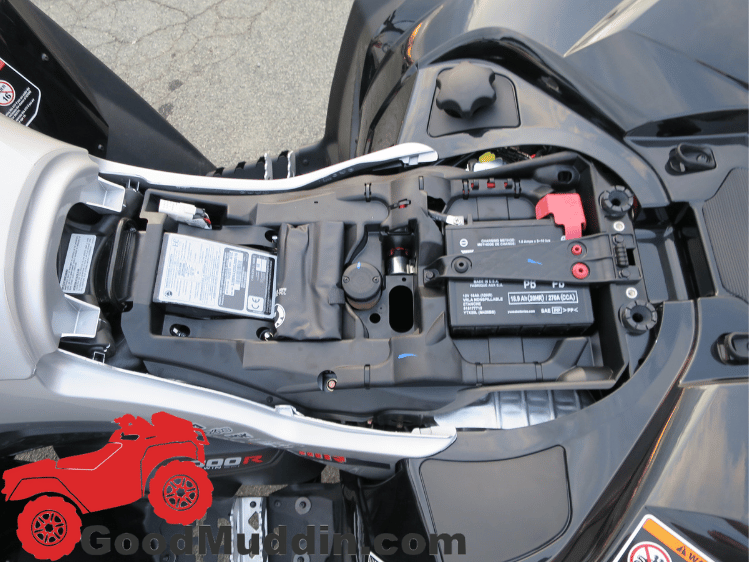The stator in your ATV is basically the charging system, or the thing that keeps and maintains power for the machine to operate.
The battery on your ATV is used to start the engine, and once started, the stator keeps the battery charged up so other parts can draw power, like the fuel injectors, headlights, power steering and anything that needs power.
The stator is critical and is needed to keep the ATV running like it should.
What makes a stator different from an alternator is the magnets. A stator uses fixed magnets and an alternator uses electromagnets, this allows alternators to produce more power at different RPM ranges. The stator is a simplified alternator made for simpler and less needy engines.
If a stator is a simpler alternator, will your machine still run without the alternator?
Will ATVs Run With A Bad Stator?
ATVs will still run with a bad or malfunctioned stator, but it won’t run for long. When the stator goes out, the electrical parts will pull power from the battery and keep doing so until the battery dies.
Without the stator, all things will pull power from the battery and eventually the engine will stop working once the battery is fully drained. How long it will take depends on the size of your battery and what load you’re pulling. It could be minutes to hours before everything stops running due to a bad stator.
Signs Of A Bad Stator
There are several things to be on the lookout for when you think the stator is bad.
- Incorrect Voltage When the Engine is Running – If your machine has a voltmeter, or if you’re using a separate one, you should be reading between 13.5 and 14.5 volts when the engine is idling. If the reading is lower or higher than this range, it indicates that something is wrong with your charging system.
- Frequent Battery Drain – If your battery is consistently dead, it could be a sign that it is malfunctioning and not maintaining a good charge.
- Check Engine Light – Many modern ATVs will trigger a check engine light if the battery isn’t charging properly or if insufficient power is being generated while the engine is running.
- Difficulty Starting – If your machine is hard or weak to start, it could suggest that the battery is drained and your charging system is not working properly.
- Poor Performance – They supply power to the spark plugs, which ignites the fuel in the engine. A bad one could lead to weak or no spark leading to poor engine performance, misfires, or the engine not running at all.
- Damaged or Melted Wires – They uses 3 yellow wires, give them a good once over to make sure they’re not melted or damaged. The heat from the engine and the environment your ride in can affect these wires and get damaged overtime. You may see a check engine light when the wires get damaged.
Fixing The Bad Stator
If you think it’s bad, here are a few things to try to confirm it.
- Check the Battery – You need to ensure that the issue isn’t due to a bad battery or one that requires charging. A good battery will read between 12 and 12.8 volts when the engine is off. If it reads lower than that, it may be bad or in need of a charge.
- Inspect the Battery Cables – Sometimes, the problem could be as simple as a loose battery cable. To address this, use a 10 mm wrench to tighten your ATV’s battery cables. Avoid using a screwdriver, even though these cables often come with Phillips-head screws.
- Examine the Charging System – Turn on the engine and let it idle. Using a voltmeter, you should be getting readings between 13.5 and 14 volts. If the reading is higher or lower, then the charging system, which includes them, might be faulty.
- Inspect the Wires – You can check the resistance of the stator-wires to confirm whether they are damaged. Every model is different, so you should consult your repair manuals for the exact readings.
- Check the Rectifier – The rectifier converts the AC from them into DC to charge the battery. Given the heat and stress they endure, rectifiers tend to wear out. If your quad is NOT charging the battery while running, it’s more common for the rectifier to fail before them, so consider replacing it first.
- Consult a Professional – Dealerships and repair shops deal with these issues regularly, and they may even recognize the problem based on your model. You can call them and ask if there’s a common problem or recall for your model. If you can’t fix the issue yourself, don’t hesitate to take it to them for repair.
Stators Can Be Hard To Replace
The difficulty level of replacing a stator can vary depending on the model and your level of mechanical skill and experience.
For someone comfortable with repair and who has some mechanical knowledge, replacing a stator can be a moderately hard. It generally requires several steps, including disassembly of the body parts and the engine.
The stator is located inside the engine block, which means you’ll need to take apart a portion of the engine to access it. Replacing the stator is not for everyone, and why I would try to replace the battery, rectifier and check the battery cables first before messing with the stator.
For most owners, it’s best to take the unit into the dealership or repair shop and let them do it for you once you know 100% it’s a bad stator.
